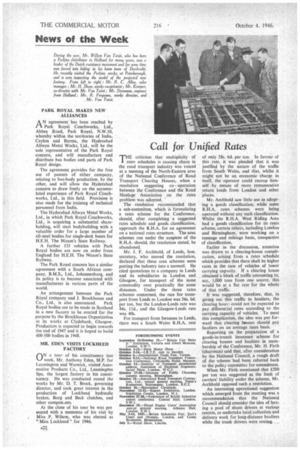Call for Unified Rates
Page 24

If you've noticed an error in this article please click here to report it so we can fix it.
T'HE criticism that multiplicity of
rates schedules is causing chaos in the road transport industry was voiced at a meeting of the North-Eastern area of the National Conference of Road Transport Clearing Houses, when a resolution suggesting co operation between the Conference and the Road Haulage Association on the rates problem was adopted.
The resolution recommended that a sub-committee, which is formulating a rates scheme for the Conference, should, after completing a suggested rates schedule and goods classification, approach the R.H.A. for an agreement on a national rates structure. The area schemes run under the auspices of the R.H.A. should, the resolution stated, be abandoned.
Mr. J. F. Archbold, of Leeds, hon. secretary, who moved the resolution, 'declared that these area schemes were putting the industry into a turmoil. He cited quotations to a company in Leeds and its subsidiaries in London and Glasgow, for transport of the same commodity over practically the same distances. Under the three rates schemes concerned, the rate for transport from Leeds to London was 56s. 6d. per ton, but the London-Leeds rate was 44s. 1 Id., and the Glasgow-Leeds rate was 40s.
For transport from Swansea to Leeds, there was a South Wales R.H.A. rate of only 28s. 6d. per ton. In favour of this rate. it was pleaded that it was justified by the nature of the traffic from South Wales, and that, whilst it might not be an economic charge in itself, the operator could recoup himself by means of more remunerative return loads from London and other places.
Mr. Archbold saw little use in adopting a goods classification, while some R.1-1A. rates schemes were being operated without any such classification. Whilst the R.H.A. West Riding Area had a goods classification for its rates scheme, certain others, including London and Birmingham, were working on a tonnage and mileage basis, irrespective of classification.
Earlier in the discussion, attention was drawn to a clearing-house complication, arising from a rates schedule which provides that there shall be higher rates in the case of vehicles of lower carrying capacity. If a clearing house obtained a block of traffic amounting to, say, 1,000 tons from one source, this would be at a flat rate for the whole of that traffic.
It was suggested, therefore, that, in giving out this traffic to hauliers, the clearing haus:. could not be expected to pay differential rates according to the carrying capacity of vehicles. To meet this complication, the idea was put forward that clearing houses should pay hauliers on an average rates basis. '
Reporting on the preparation of a goods-in-transit insurance scheme for clearing houses and hauliers in membership of the Conference, Mr, H. Firth (chairman) said that, after consideration by the National Council, a rough draft of the scheme had been referred back to the policy committee for amendment. When Mr. Firth mentioned that £200 per ton was suggested as the limit of carriers' liability under the scheme, Mr. Archbold opposed such a restriction.
An interesting operational suggestion which emerged from the meeting was a recommendation that the NationaJ, Council should consider the idea of hav-, ing a pool of shunt drivers at variants centres, to undertake local collectiOn and delivery work for long-distance hauliers while the trunk drivers were resting...,




































































